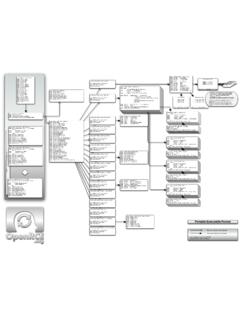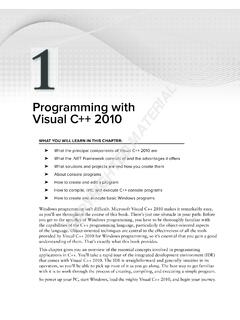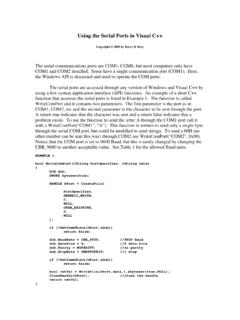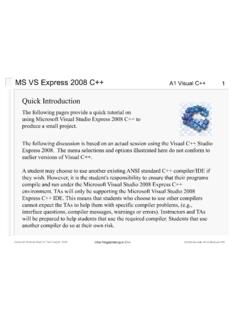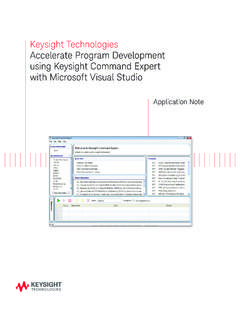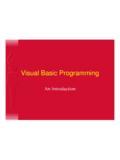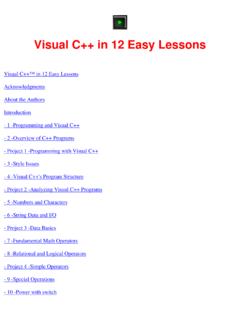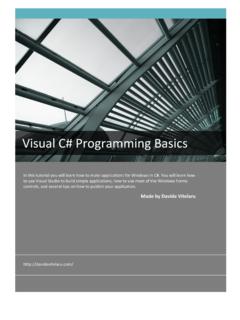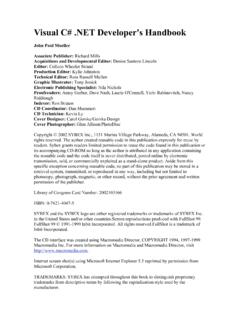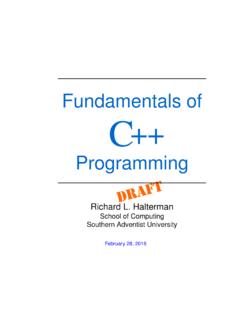Transcription of C++: Under the Hood
1 The original article is taken from Illustrations are taken from Archived content. No warranty is made as to technical accuracy. Content may contain URLs that were valid when originally published, but now link to sites or pages that no longer exist. visual C and C++ (General) Technical Articles C++: Under the hood Jan Gray March 1994 Jan Gray is a Software Design Engineer in Microsoft s visual C++ Business Unit. He helped design and implement the Microsoft visual C++ compiler. Introduction It is important to understand how your programming language is implemented.
2 Such knowledge dispels the fear and wonder of What on earth is the compiler doing here? ; imparts confidence to use the new features; and provides insight when debugging and learning other language features. It also gives a feel for the relative costs of different coding choices that is necessary to write the most efficient code day to day. This paper looks Under the hood of C++, explaining run-time C++ implementation details such as class layout techniques and the virtual function call mechanism. Questions to be answered include: How are classes laid out?
3 How are data members accessed? How are member functions called? What is an adjuster thunk? What are the costs: Of single, multiple, and virtual inheritance? Of virtual functions and virtual function calls? Of casts to bases, to virtual bases? Of exception handling? First, we ll look at struct layout of C-like structs, single inheritance, multiple inheritance, and virtual inheritance, then consider data member access and member functions, virtual and not. We ll examine the workings of constructors, destructors, and assignment operator special member functions and dynamic construction and destruction of arrays.
4 Finally, we ll briefly consider the impact of exception-handling support. For each language feature topic, we ll very briefly present motivation and semantics for the language feature (although Introduction to C++ this is not), and examine how the language feature was implemented in Microsoft visual C++ . Note the distinction between abstract language semantics and a particular concrete implementation. Other vendors have sometimes made different implementation choices for whatever reasons. In a few cases we contrast the visual C++ implementation with others.
5 Class Layout In this section we ll consider the storage layouts required for different kinds of inheritance. C-like Structs As C++ is based upon C, it is mostly upwards-compatible with C. In particular, the working papers specify the same simple struct layout rules that C has: Members are laid out in their declaration order, subject to implementation defined alignment padding. All C/C++ vendors ensure that valid C structs are stored identically by their C and C++ compilers. Here A is a simple C struct with the obvious expected member layout and padding.
6 Struct A { char c; int i; }; C-like Structs with C++ Features Of course, C++ is an object-oriented programming language: It provides inheritance, encapsulation, and polymorphism by extending the mundane C struct into the wondrous C++ class. Besides data members, C++ classes can also encapsulate member functions and many other things. However, except for hidden data members introduced to implement virtual functions and virtual inheritance, the instance size is solely determined by a class s data members and base classes.
7 Here B is a C-like struct with some C++ features: There are public/protected/private access control declarations, member functions, static members, and nested type declarations. Only the non-virtual data members occupy space in each instance. Note that the standards committee working papers permit implementations to reorder data members separated by an access declarator, so these three members could have been laid out in any order. (In visual C++, members are always laid out in declaration order, just as if they were members of a C struct) struct B { public: int bm1; protected: int bm2; private: int bm3; static int bsm; void bf(); static void bsf(); typedef void* bpv; struct N { }; }; Single Inheritance C++ provides inheritance to factor out and share common aspects of different types.
8 A good example of a classes-with-inheritance data type organization is biology s classification of living things into kingdoms, phyla, orders, families, genus, species, and so on. This organization makes it possible to specify attributes, such as mammals bear live young at the most appropriate level of classification; these attributes are then inherited by other classes, so we can conclude without further specification that whales, squirrels, and people bear live young. Exceptional cases, such as platypi (a mammal, yet lays eggs), will require that we override the inherited attribute or behavior with one more appropriate for the derived class.
9 More on that later. In C++, inheritance is specified by using the : base syntax when defining the derived class. Here D is derived from its base class C. struct C { int c1; void cf(); }; struct D : C { int d1; void df(); }; Since a derived class inherits all the properties and behavior of its base class, each instance of the derived class will contain a complete copy of the instance data of the base class. Within D, there is no requirement that C s instance data precede D s. But by laying D out this way, we ensure that the address of the C object within D corresponds to the address of the first byte of the D object.
10 As we shall see, this eliminates adding a displacement to a D* when we need to obtain the address of its embedded C. This layout is used by all known C++ implementations. Thus, in a single inheritance class hierarchy, new instance data introduced in each derived class is simply appended to the layout of the base class. Note our layout diagram labels the address points of pointers to the C and D objects within a D. Multiple Inheritance Single inheritance is quite versatile and powerful, and generally adequate for expressing the (typically limited) degree of inheritance present in most design problems.
